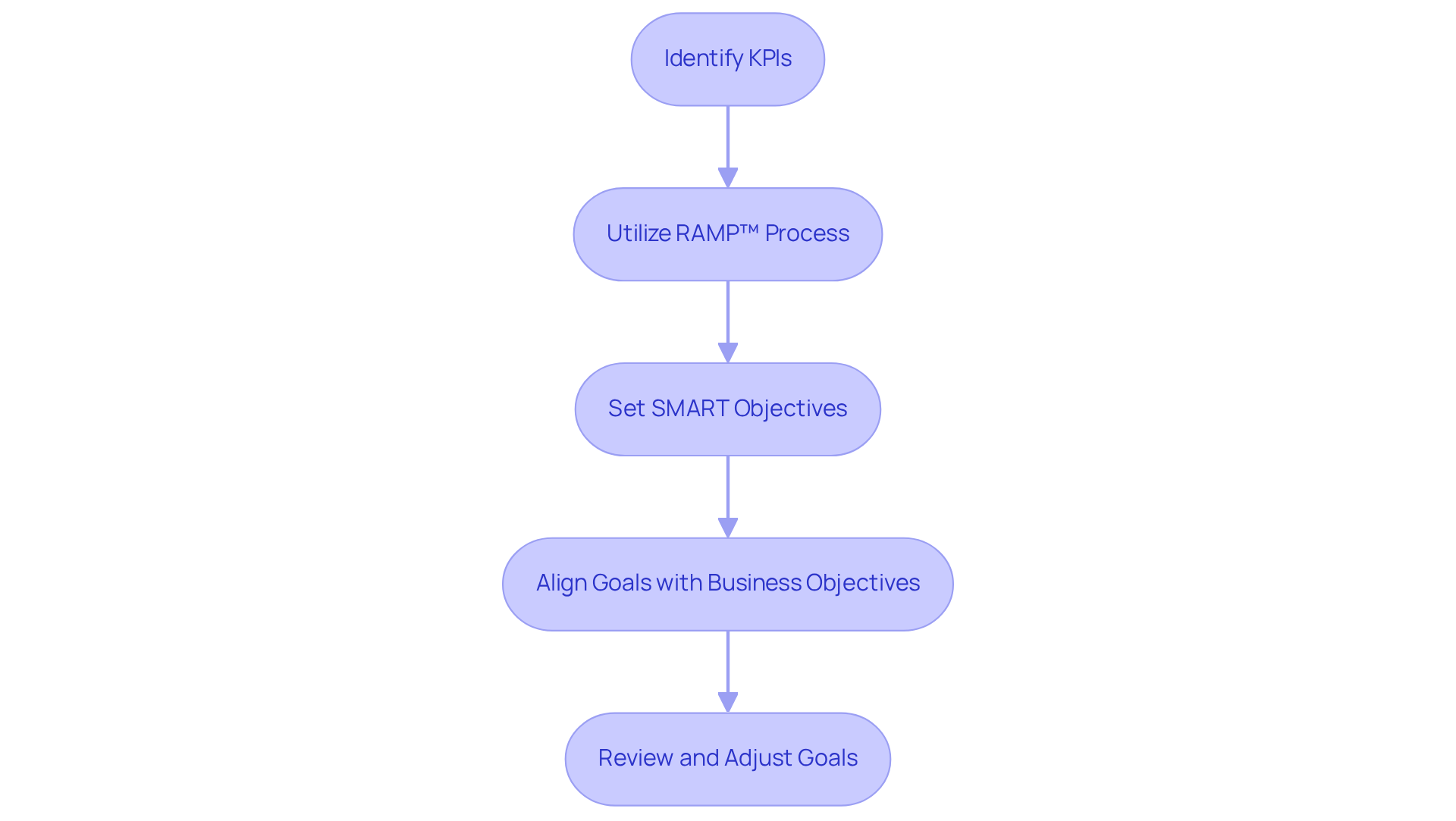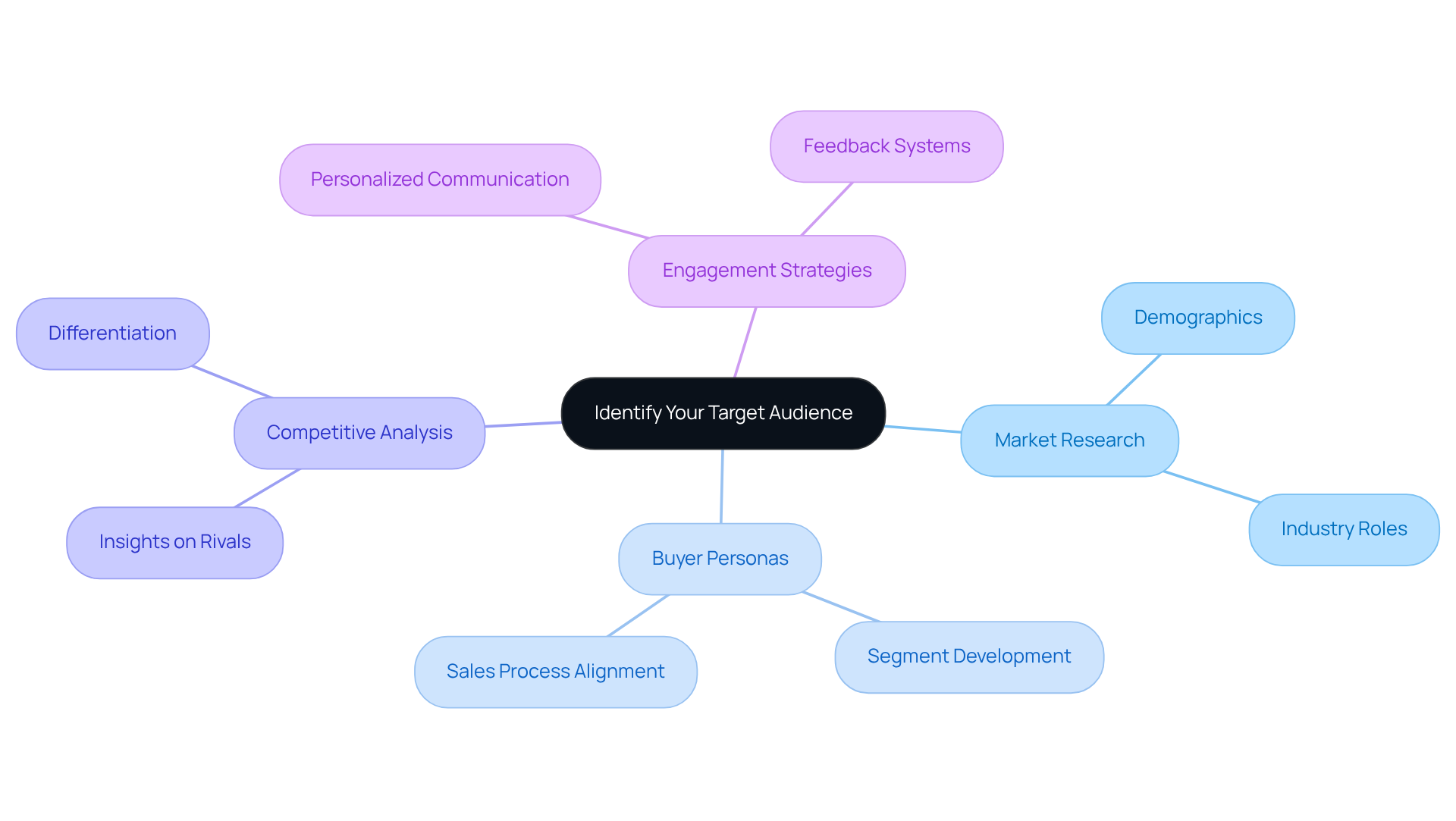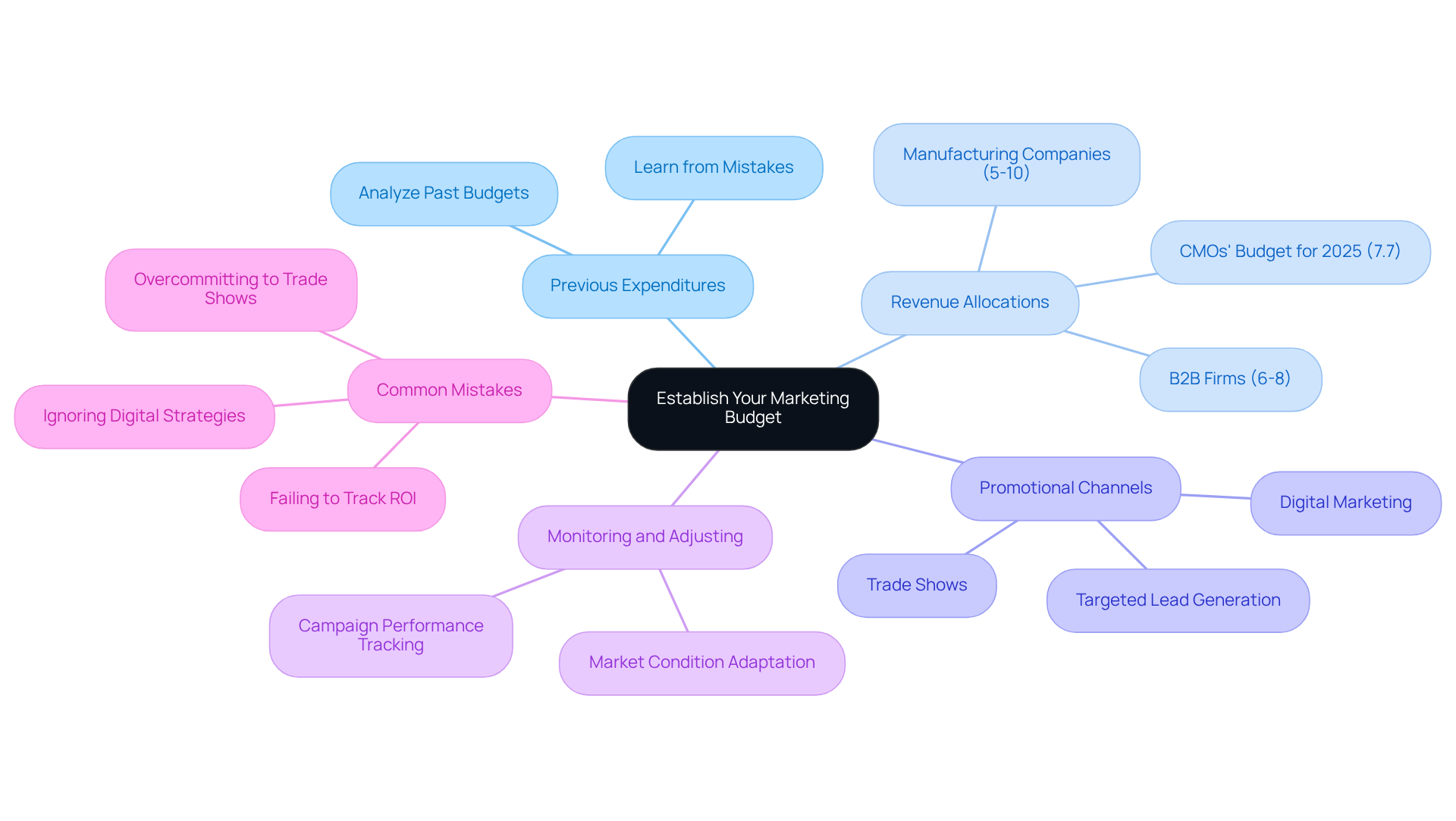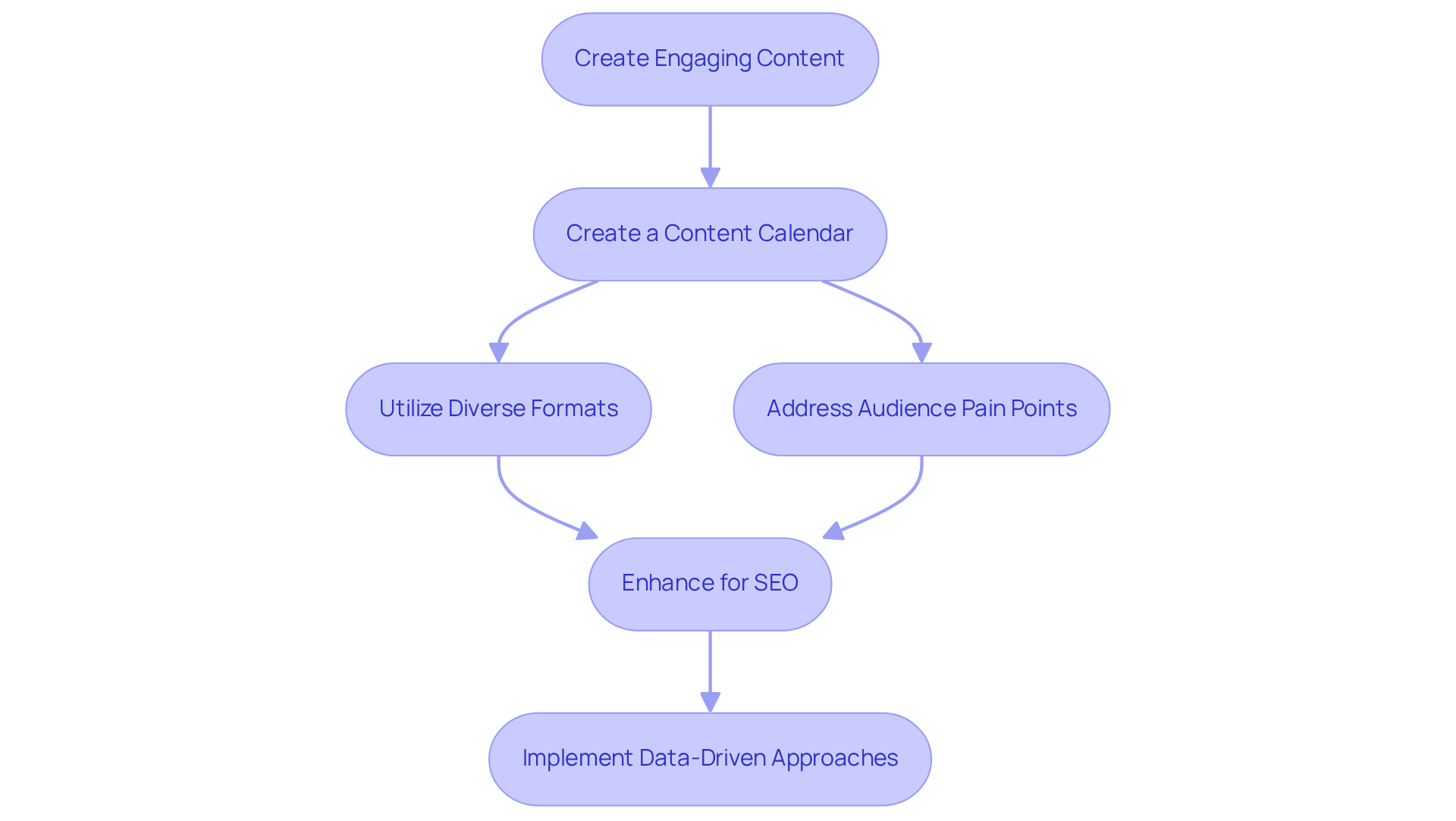Overview
Digital marketing is crucial for manufacturers, encompassing essential steps such as:
- Defining marketing goals
- Identifying the target audience
- Establishing a marketing budget
- Creating engaging content
Aligning promotional goals with overarching business objectives is paramount. Understanding customer needs through thorough research, strategically allocating resources, and producing relevant content are critical components. These strategies enhance visibility and drive conversions within the manufacturing sector, ultimately leading to greater success. Manufacturers must prioritize these steps to effectively navigate the digital landscape and achieve their marketing objectives.
Introduction
In an increasingly competitive landscape, manufacturers are discovering that effective digital marketing is not merely an option—it's an absolute necessity. This article delineates four essential steps that can transform a manufacturer’s approach to engaging potential customers, from defining clear marketing goals to crafting engaging content tailored to specific audiences.
However, as the digital realm continues to evolve, how can manufacturers ensure that their strategies remain relevant and impactful? This exploration delves into the strategies that can elevate digital marketing efforts and drive measurable results within the manufacturing sector.
Define Your Marketing Goals
To effectively define your promotional goals, begin by identifying key performance indicators (KPIs) that align with your business objectives. Utilize Market Veep's to ensure these indicators are in harmony with your overall aims. This approach guarantees that your promotional efforts are both measurable and relevant. For instance, establishing SMART objectives—specific, measurable, achievable, relevant, and time-bound—can significantly enhance your promotional strategy. A practical example of digital marketing for manufacturers would be setting a goal to increase website traffic by 30% within six months, a target successfully achieved by numerous manufacturing companies after implementing SMART criteria.
Aligning your promotional goals with overarching business objectives is essential for maintaining coherence across your organization. This alignment fosters collaboration between departments and ensures that promotional initiatives support broader business plans. Case studies from B2B manufacturing firms illustrate the effectiveness of digital marketing for manufacturers; companies that have synchronized their promotional goals with business objectives report improved lead generation and more efficient sales processes.
Regularly reviewing and adjusting your goals based on performance data and market changes is crucial. Ongoing monitoring allows companies to adapt their strategies in response to evolving market conditions, ensuring sustained relevance and effectiveness. By cultivating a culture of agility and responsiveness, manufacturers can enhance their promotional efforts and achieve measurable outcomes.
Let's Talk! Discover how Market Veep's RAMP™ process can assist you with KPI mapping and help develop a tailored 90-day game plan that meets your unique business needs.

Identify Your Target Audience
Conduct thorough market research to gather data on potential customers, focusing on demographics and industry roles that are critical for digital marketing for manufacturers. At Market Veep, we emphasize the development of comprehensive buyer personas that illustrate various segments of your target group, ensuring that your digital marketing for manufacturers strategies are customized effectively. This involves aligning your sales process design with these personas to enhance engagement and conversion rates through digital marketing for manufacturers.
Examine rivals to gain insights into their target market and positioning, which can guide your strategic choices in digital marketing for manufacturers. For instance, understanding how competitors engage with similar personas in for manufacturers can help differentiate your offerings.
Furthermore, employ surveys and feedback systems in your digital marketing for manufacturers to deepen your understanding of preferences and needs, thereby boosting your promotional effectiveness. Engaging with your audience through personalized communication in digital marketing for manufacturers can drive 18 times more revenue than generic outreach, making it essential to adapt your strategies based on real-time insights.

Establish Your Marketing Budget
Examine previous promotional expenditures to inform future budgeting choices, ensuring that lessons learned direct resource distribution. Allocate a percentage of revenue to promotion, typically ranging from 5-10% for manufacturing companies, to maintain competitiveness and visibility in the market. Notably, CMOs indicate that their promotional budgets for 2025 remain unchanged at 7.7% of total company revenue, providing a broader context for this allocation.
Prioritize expenditure based on the effectiveness of various promotional channels, focusing on those that yield the highest return on investment, such as digital marketing for manufacturers and targeted lead generation. B2B firms generally designate approximately 6-8% of their income for promotion, serving as a standard for manufacturers.
Regularly monitor and in response to campaign performance and evolving market conditions, allowing for flexibility and responsiveness to new opportunities. Be mindful of common mistakes, such as overcommitting to trade shows, which can lead to wasted resources.
Highlighting Market Veep's success, the agency has achieved a 3X increase in organic traffic for manufacturing clients, showcasing the effectiveness of digital marketing for manufacturers through strategic budgeting and promotional efforts.

Create Engaging Content
Producing captivating material for manufacturers necessitates a strategic method, beginning with the creation of a well-organized schedule. This calendar acts as a roadmap for planning and organizing material production, ensuring that all resources align with broader marketing objectives and KPI mapping. A strong schedule for material not only boosts efficiency but also minimizes the disorder of last-minute creation, enabling teams to concentrate on delivering high-quality results.
To address the varied preferences of manufacturing groups, it’s crucial to include a blend of formats, such as blogs, videos, infographics, and podcasts. Research shows that 94% of marketers think extensive thought leadership materials improve brand perception, making it essential to create resources that connect with intended groups. For example, businesses that release 8 to 16 updates each month can encounter up to four times more inbound traffic, emphasizing the significance of regular material output.
Addressing the specific pain points of your target group is vital. Content should focus on providing solutions to challenges faced by professionals in the manufacturing sector, such as improving operational efficiency or navigating supply chain complexities. Captivating material that addresses these issues can greatly improve connection with viewers and boost conversions.
Furthermore, enhancing material for search engines is essential for boosting visibility and search rankings. With 82% of leading marketers crediting their achievement to a profound comprehension of their target market, utilizing can assist in guaranteeing that your material reaches the appropriate individuals at the correct moment.
Integrating data-driven promotional approaches can further improve the impact of your material. By examining market share insights and comprehending buyer personas, manufacturers can customize their material to fulfill the distinct requirements and preferences of their target audience. Successful case studies in B2B manufacturing demonstrate the effectiveness of these strategies. For instance, companies that enable employees to produce and share material related to their expertise observe engagement rates rise, with leads from such material being seven times more likely to convert into sales. By implementing a structured content calendar and focusing on diverse, audience-centric content, manufacturers can enhance their digital marketing efforts and achieve measurable results.

Conclusion
Defining effective digital marketing strategies for manufacturers is not just important; it is essential for navigating today’s competitive landscape. By concentrating on key steps—such as establishing clear marketing goals, identifying target audiences, setting appropriate budgets, and creating engaging content—manufacturers can ensure their promotional efforts align with business objectives and resonate with potential customers.
This article underscores the importance of SMART goals, thorough market research, and strategic budgeting to optimize marketing efforts. Understanding buyer personas and crafting tailored content are highlighted as pivotal strategies that can significantly enhance engagement and conversion rates. Moreover, the necessity for continuous monitoring and adaptation of marketing strategies is emphasized, enabling manufacturers to remain agile in a dynamic market.
Ultimately, the digital marketing landscape for manufacturers is replete with opportunities for those willing to invest time and resources into developing a comprehensive approach. By implementing these essential steps, manufacturers can not only improve visibility and lead generation but also cultivate long-term relationships with their target audience. Embracing these strategies will empower manufacturers to thrive in an increasingly digital world, making it imperative to act on these insights for sustained success.
Frequently Asked Questions
To define your marketing goals effectively, start by identifying key performance indicators (KPIs) that align with your business objectives. Utilizing Market Veep's RAMP™ process can help ensure these indicators are relevant and measurable.
The SMART criteria stand for Specific, Measurable, Achievable, Relevant, and Time-bound objectives. Using this framework can significantly enhance your promotional strategy, such as setting a goal to increase website traffic by 30% within six months.
Aligning promotional goals with overarching business objectives is essential for coherence across the organization. This alignment fosters collaboration between departments and ensures that promotional initiatives support broader business plans.
B2B manufacturing firms that synchronize their promotional goals with business objectives report improved lead generation and more efficient sales processes.
Regularly reviewing and adjusting your marketing goals based on performance data and market changes is crucial. Ongoing monitoring allows companies to adapt their strategies to evolving market conditions, ensuring sustained relevance and effectiveness.
Market Veep's RAMP™ process can assist with KPI mapping and help develop a tailored 90-day game plan that meets your unique business needs.











